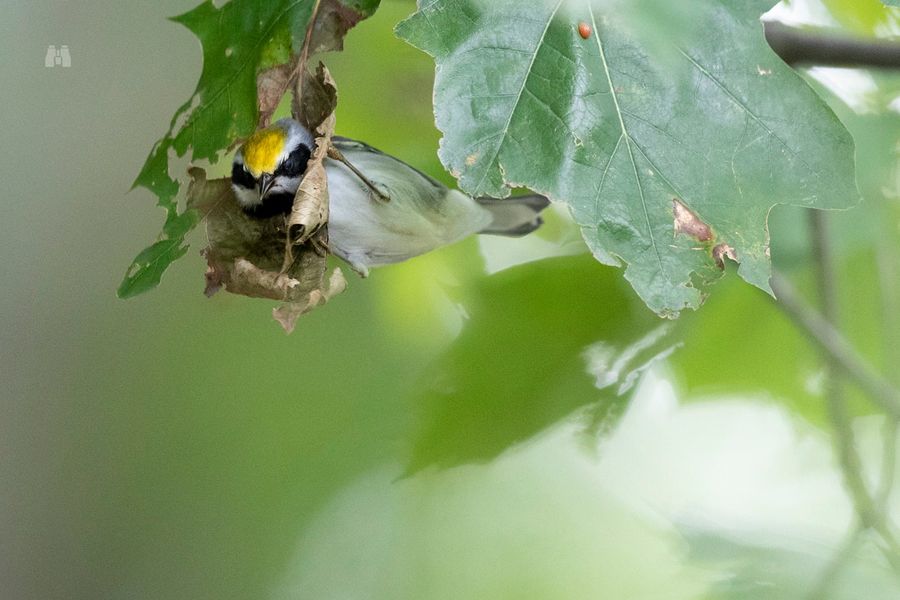

By: Anne W. Semmes
A curious event in nature involving two bird species witnessed recently at Tod’s Point has intrigued a number of birders, nature lovers, and naturalists of note. Captured on camera by a Greenwich birder/photographer, Jim Muchmore, is a very rarely seen Golden-winged Warbler (GWW) with his head stuck in a leaf, struggling to free himself, when a chickadee lands on him.
Birder Jim is startled by this action, exchanges his camera for binoculars to view this action. “At first I thought it [the chickadee] was attacking it or being defensive,” he writes. “Then I realized that the chickadee was actually freeing the GWW – once it was free the birds went their separate ways peacefully, making me realize that the chickadee had come to the rescue.”
Spoiler alert: there is scant history of one bird species helping another bird species.But Jim continues his heartening message of the event as sent out on Facebook: “It might be one of the most interesting things I’ve witnessed as a birder. It would be great to hear if anyone else has witnessed two different species help each other to safety. Humans need to be more like chickadees!”
It was my Ithaca, N.Y. wildlife photographer daughter, Melissa Groo who alerted me to the Facebook posting: “There is so much we don’t know,” she wrote. “Check out this example of what looks to be a kind of interspecies altruism. Chickadee helps a Golden-Winged Warbler. Great work, James Muchmore!”
Jim Muchmore lives in the Milbrook area of Greenwich where the streets have bird names. And it turns out it’s a bird rich area. His back yard he has found to be a “migrant trap” or corridor for birds. Since moving out of New York City two years ago with his young family, Jim has identified 125 species in his back yard. “I’m looking crazy at 5 a.m. with binoculars. The sun hits those trees first,” he points, where he’s spotted a Cape May Warbler, an Orange Crown Warbler, a Black Throated Green Warbler, a Chestnut-sided Warbler, a Hooded Warbler, a Cerulean Warbler. four Scarlet Tanagers, and so many Red Eyed Vireos. He’s recorded them all on e-bird. “I don’t think people would believe me,” he tells.
But back to that interspecies rescue as Jim sees it. The responses to his Facebook were intriguing and impressive. “Extremely interesting,” posted ecologist/ author Carl Safina. “It makes sense to me that a chickadee would do something like this,” posted Ellen Morosoff Pemrick. “Other birds seem to follow them to food sources.”
The itch came to reach out to bird experts for their take on those “rescue” photos. “An amazing story!,” replies Patrick Comins, who heads up the Connecticut Audubon Society. “It really seems like the chickadee is helping the warbler. Some think that the markings of GWW are a mimic of chickadees to assist with them mixing in with the foraging flocks in migration. Who knows if that hypothesis is valid.”
Patrick attaches an intriguing scientific paper that investigates, “Is the Golden-winged Warbler a social mimic of the Black-capped Chickadee? “The study shows how the two birds have “an extensive overlap in range and in habitat.” The warbler obtains much of its food as does the chickadee from buds, but the warbler’s slender bill is more successful at probing than the chickadees stubbier bill. But no word of one bird feeding another or any interspecies rescues!
Daughter Melissa then directs me to the Cornell Laboratory of Ornithology bird behavior specialist, Kevin J. McGowan, Ph.D. for his take: “Bird behavior is complex, and everything is not what it seems to be from our very-biased human perspective…So. With these photos, what do I see and what do I think? Chickadees and warblers gain nothing or only very little from their association, except protection from predators in mixed species foraging flocks. Golden-winged Warblers and Black-capped Chickadees actually forage in much the same way and probably compete for the same foods, so I’m not thinking they’re great friends in these flocks. In fact, one might suspect that they would be more competitive, and therefore less friendly than other chickadee/warbler matchups…
“Therefore, my first reaction is that the chickadee saw a mostly immobile Golden-winged Warbler that it felt hostile about. It landed on it, and it didn’t fly away. Odd. So the chickadee flew away, perhaps still clutched to the warbler (something chickadees don’t normally do; they don’t carry anything in their feet), and the warbler was dislodged. They separate and no further interaction occurs. No ‘thank you’ or ‘let’s forage together now.’”
The opinion I received from an even more august bird behavior expert Bernd Heinrich spoke to that same self-centered, self- preservation bird behavior. “It certainly looks like the GWW has its head through a hole in the dried leaf- likely had been checking for any of a number of insects or spiders hiding in such places. I don’t see the helping part.”
“Certainly,” he continued, “the warbler could have gotten out easily. The chickadee is fluttering about, investigating. Chickadees are interested in alarm calls, even those of other birds, and come to investigate- its curiosity- they find out what might be dangerous. Chickadees also routinely check out such leaf curls for caterpillars, pupae and /or spiders they contain. Maybe, it presumed the warbler was extracting one and wanted to get it first.”
But then, there’s Jim Muchmore telling what he saw. “The Golden-wing was panicking. In my eight years of birding experience I’ve never seen anything like what this felt like. This chickadee has landed on another bird and is holding on. And it is pulling the warbler back. I’ve never witnessed a bird landing on another bird. I’ve seen them fight each other but never seen a songbird do that. This was something different in bird behavior. It felt different. In this time of Covid everyone is trying to be a team player. To do the right thing. That’s what the chickadee was doing. Helping out the entire team.”
My daughter Melissa gets the last word. “I think there are definitely scientists out there like Carl Safina, who commented on my Facebook post, who might argue that why not consider that such an altruistic act would also enhance survival of the chickadee. As that paper mentions that you shared, the chickadee depends on the more proficient bill of the warbler to open up buds. The survival of the warbler can help the survival of the chickadee. So why not that explanation for an altruistic act?”




